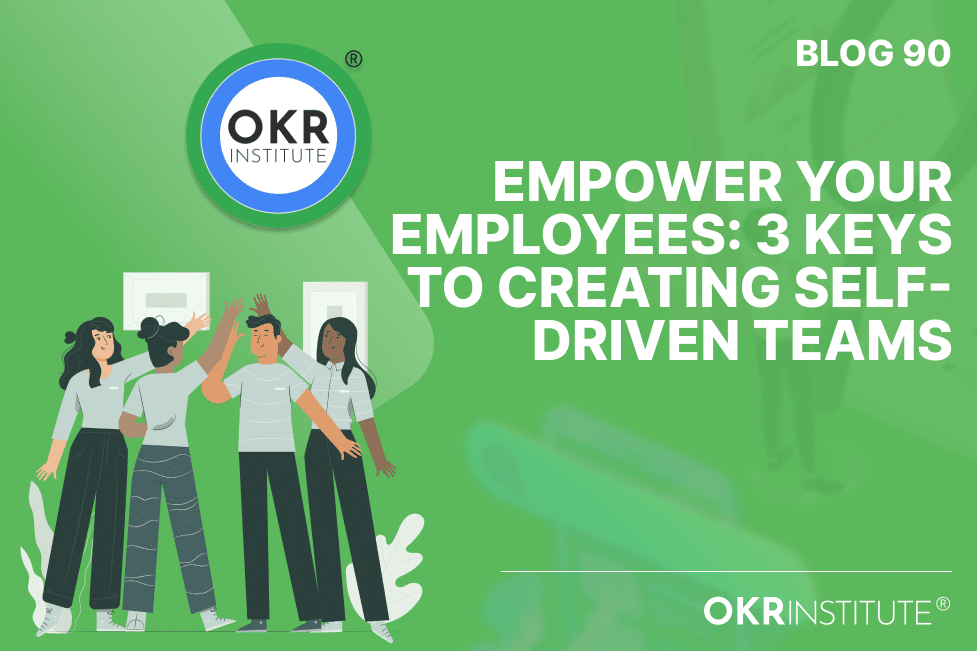Empower Your Employees: 3 Keys to Creating Self-Driven Teams

What are Self-Driven Teams?
Self-driven teams, also known as self-managed or self-organizing teams, are groups of individuals who take collective responsibility for achieving their goals, managing their day-to-day operations, and making decisions without constant oversight from a traditional hierarchical management structure.
Key Characteristics of Self-Driven Teams:
- Autonomy: Team members have a high degree of autonomy and decision-making authority over their work processes, task assignments, and problem-solving approaches.
- Shared Leadership: Leadership roles are distributed among team members, and leadership responsibilities can rotate or be shared based on the team’s needs and individual strengths.
- Collective Accountability: The team is collectively accountable for its performance, outcomes, and decisions, fostering a sense of ownership and shared responsibility.
- Cross-Functional Expertise: Team members often possess a diverse set of skills and expertise, enabling them to handle a wide range of tasks and challenges without relying heavily on external resources.
- Continuous Learning and Improvement: Self-driven teams embrace a culture of continuous learning, experimentation, and improvement, actively seeking feedback and adapting their processes and approaches as needed.
Benefits of Self-Driven Teams for Organizations:
- Increased Motivation and Engagement: By giving team members autonomy and a sense of ownership, self-driven teams foster higher levels of motivation, engagement, and job satisfaction.
- Faster Decision-Making: With the ability to make decisions without bureaucratic delays, self-driven teams can respond more quickly to changing circumstances and customer needs.
- Improved Problem-Solving: The diverse expertise and collective intelligence of self-driven teams enable them to tackle complex problems more effectively and generate innovative solutions.
- Enhanced Flexibility and Adaptability: Self-driven teams are better equipped to adapt to changing market conditions, customer demands, and organizational priorities due to their agility and autonomy.
- Increased Productivity and Efficiency: By eliminating unnecessary layers of management and streamlining decision-making processes, self-driven teams can often achieve higher productivity and efficiency.
Self-driven teams represent a shift from traditional hierarchical structures to a more empowered, collaborative, and agile approach to work, enabling organizations to unlock the full potential of their employees and foster a culture of innovation and continuous improvement.
The Role of Leadership
The role of leadership in creating self-driven teams is crucial, as it requires a significant shift from traditional command-and-control management styles. Leaders must embrace a more facilitative and supportive approach, empowering teams to take ownership and make decisions independently.
Effective leaders in self-driven teams act as coaches and mentors, providing guidance and removing obstacles that may hinder the team’s progress. Instead of dictating tasks and micromanaging, they create an environment that fosters autonomy, trust, and accountability.
Leaders must learn to relinquish control and resist the temptation to intervene unnecessarily. They should focus on setting clear goals, communicating the organization’s vision, and providing the necessary resources and support for teams to achieve their objectives. By stepping back and allowing teams to self-organize and make decisions, leaders encourage innovation, creativity, and a sense of ownership among team members.
Additionally, leaders play a vital role in creating a culture that celebrates and rewards self-driven behavior. They should recognize and acknowledge the team’s achievements, celebrate successes, and provide constructive feedback to facilitate continuous improvement. By leading by example and demonstrating trust in their teams, leaders can inspire and motivate team members to take initiative and embrace a self-driven mindset.
Building a Culture of Trust and Autonomy
Creating a culture of trust and autonomy is essential for fostering self-driven teams. Trust is the foundation upon which team members can feel empowered to take ownership, make decisions, and execute tasks without constant oversight. Leaders must demonstrate their confidence in the team’s abilities by granting them autonomy and decision-making power.
Encouraging autonomy involves allowing teams to self-organize, set their own processes, and determine the best approach to achieve their goals. This autonomy fosters a sense of ownership and accountability, as team members take responsibility for their actions and outcomes. Leaders should resist the temptation to micromanage, instead providing guidance and support when needed.
Open communication and transparency are crucial for building trust and autonomy. Teams should have access to relevant information, including organizational goals, strategies, and performance metrics. Regular check-ins, retrospectives, and feedback sessions allow for open dialogue, addressing concerns, and celebrating successes. Transparency breeds trust and aligns the team’s efforts with the broader organizational objectives.
By fostering a culture of trust and autonomy, organizations empower self-driven teams to thrive. Team members feel valued, motivated, and committed to delivering their best work, driving innovation and achieving exceptional results.
Team Composition and Diversity
Assembling a self-driven team requires careful consideration of the diverse skills, experiences, and perspectives that each member brings to the table. A well-rounded team with complementary strengths and backgrounds is more likely to approach challenges from multiple angles, fostering innovation and creative problem-solving.
When building a self-driven team, it’s crucial to strike a balance between individuals with varying personalities, work styles, and communication preferences. This diversity can contribute to a dynamic and engaging team dynamic, where members can learn from one another and challenge each other’s assumptions constructively.
Furthermore, fostering an environment of collaboration and knowledge sharing is essential for self-driven teams to thrive. Encouraging open communication, active listening, and a willingness to learn from one another can promote a culture of continuous improvement and growth. Team members should feel empowered to share their unique insights and expertise, contributing to the collective wisdom of the group.
By embracing diversity in team composition, organizations can create self-driven teams that are better equipped to tackle complex challenges, adapt to changing circumstances, and drive innovation within the organization.
OKR Setting and Alignment
Setting clear and meaningful goals is crucial for self-driven teams to thrive. These goals should align with the organization’s overarching objectives while allowing teams the autonomy to define their own processes and approaches.
Establishing clear and meaningful goals involves engaging the team in the goal-setting process. Leaders should facilitate discussions to ensure that team members understand the organizational objectives and how their work contributes to achieving them. By involving the team, leaders foster a sense of ownership and commitment to the goals.
Aligning team goals with organizational objectives is essential for ensuring that the team’s efforts are focused and aligned with the broader vision and strategy of the organization. This alignment helps to prevent teams from working in silos or pursuing objectives that are misaligned with the organization’s priorities.
Enabling teams to define their own processes is a key aspect of self-driven teams. While the goals may be set at a higher level, teams should have the autonomy to determine the specific processes, methodologies, and approaches they will use to achieve those goals. This autonomy empowers teams to leverage their collective expertise, creativity, and problem-solving abilities to find the most effective ways of working.
By striking the right balance between clear goal setting and alignment with organizational objectives, while also enabling teams to define their own processes, organizations can create an environment where self-driven teams can thrive and deliver exceptional results.
Training and Development
Fostering an environment of continuous learning and growth is crucial for self-driven teams. Provide your team members with the necessary training and resources to develop their skills and knowledge. Encourage them to attend workshops, seminars, or online courses that align with their roles and interests. Allocate a budget for professional development and make it accessible to all team members.
Furthermore, cultivate a culture of knowledge sharing within the team. Encourage team members to share their expertise, insights, and best practices with one another. This not only promotes learning but also strengthens collaboration and teamwork.
Developing leadership skills within the team is equally important. Identify individuals who demonstrate leadership potential and provide them with opportunities to lead projects or initiatives. Offer leadership training programs that focus on effective communication, decision-making, conflict resolution, and team management. By nurturing leadership skills, you empower team members to take ownership and drive the team’s success.
Remember, self-driven teams thrive when their members are equipped with the right skills and knowledge. Continuous learning and development not only enhance individual growth but also contribute to the overall performance and adaptability of the team.
Performance Management and Feedback
Effective performance management and feedback are crucial for self-driven teams to thrive. Implementing a system that promotes accountability, continuous improvement, and recognition is essential.
One approach is to establish a regular cadence for team members to provide peer feedback. This can be facilitated through anonymous surveys, one-on-one conversations, or team retrospectives. The key is to create a safe environment where constructive criticism is welcomed, and individuals feel comfortable sharing their perspectives.
Additionally, it’s important to have a clear and objective method for evaluating individual and team performance. This could involve setting measurable goals aligned with the organization’s objectives and regularly reviewing progress. Performance evaluations should be a two-way dialogue, allowing team members to share their accomplishments, challenges, and areas for growth.
Celebrating team successes is equally important. When milestones are achieved or exceptional work is delivered, it’s essential to recognize and reward the team’s efforts. This could be through public acknowledgment, bonuses, or team-building activities. Celebrating success reinforces positive behavior and fosters a sense of pride and motivation within the team.
Failures should also be embraced as learning opportunities. When things don’t go as planned, it’s crucial to have an open and honest discussion about what went wrong, what can be learned, and how the team can improve moving forward. This culture of continuous improvement and learning from mistakes is vital for self-driven teams to adapt and grow.
Challenges and Pitfalls
Transitioning to self-driven teams can present several challenges that organizations must be prepared to address. One of the primary obstacles is overcoming resistance to change. Employees may feel threatened by the shift in power dynamics and the increased autonomy and accountability that comes with self-driven teams. Clear communication, training, and involving employees in the transition process can help mitigate resistance and foster buy-in.
Another challenge lies in addressing conflicts and power dynamics within the teams themselves. Without a traditional hierarchical structure, team members may struggle to resolve conflicts or make decisions collaboratively. Providing training in conflict resolution, decision-making processes, and facilitation skills can help teams navigate these challenges effectively.
Additionally, organizations may face difficulties in letting go of traditional command-and-control management styles. Leaders may struggle to trust their teams and relinquish control, leading to micromanagement or undermining the team’s autonomy. Coaching and support for leaders to embrace a more facilitative role are crucial for the successful implementation of self-driven teams.
Furthermore, organizations must be prepared to address issues related to accountability and performance management. Without clear goals, metrics, and feedback mechanisms, self-driven teams may lose focus or struggle to maintain productivity. Establishing transparent and fair performance evaluation processes that align with the team’s objectives is essential for ensuring accountability and continuous improvement.
Best Practices and Case Studies
Successful organizations that have implemented self-driven teams have valuable lessons to share. At Zappos, the online retailer transitioned to a flat, self-managed structure called “Holacracy.” While the transition was challenging, it fostered greater employee engagement, agility, and customer-centricity. Lessons learned include the importance of thorough training, clear governance processes, and a culture that truly embraces self-organization.
Spotify’s agile “Squads” model, where cross-functional teams have end-to-end responsibility for specific product areas, is another notable example. Key practices include giving teams autonomy over their ways of working, fostering continuous learning and improvement, and aligning teams through clear vision and purpose rather than rigid processes.
At Gore, the maker of Gore-Tex fabrics, self-driven teams have been a core part of the company’s unique “lattice” structure for decades. Employees choose their own teams and projects based on their interests and skills, fostering intrinsic motivation and innovation. Gore’s success highlights the importance of a strong culture of freedom, fairness, and commitment to stakeholders.
While self-driven teams can thrive in various contexts, best practices include:
- Clearly defining the team’s purpose, goals, and boundaries for autonomous decision-making.
- Providing training in self-management, conflict resolution, and team dynamics.
- Fostering psychological safety and trust within teams and across the organization.
- Implementing lightweight processes for coordination, prioritization, and conflict resolution.
- Aligning teams through a clear, shared vision and values rather than rigid hierarchies.
- Continuously improving team processes through retrospectives and feedback loops.
- Adapting team structures and practices to the organization’s context and needs.
Ultimately, successful self-driven teams require a shift in mindset from command-and-control to empowerment and trust in employees’ intrinsic motivation and capabilities.
Measuring Success and Continuous Improvement
Defining clear metrics for success is crucial when implementing self-driven teams. These metrics should align with the organization’s overall goals and objectives, as well as the specific goals set for each team. Typical metrics may include productivity, quality, customer satisfaction, and employee engagement.
Regularly monitoring and adjusting team processes is essential to ensure that self-driven teams remain effective and efficient. This may involve gathering feedback from team members, conducting retrospectives, and analyzing performance data. Based on these insights, team processes and structures can be adjusted to address any challenges or bottlenecks.
Encouraging a culture of continuous improvement and innovation is vital for self-driven teams to thrive. Teams should be empowered to experiment, learn from failures, and implement new ideas and approaches. This can be facilitated through regular brainstorming sessions, hackathons, or innovation challenges. Additionally, providing resources for professional development and learning opportunities can help team members continuously enhance their skills and knowledge.
By establishing clear metrics, regularly monitoring and adjusting processes, and fostering a culture of continuous improvement, organizations can ensure that self-driven teams remain agile, adaptable, and effective in achieving their goals.
CEO of the OKR Institute
Related Courses
Recent Posts
Tags
#OKR
#OKR Coaching
#OKR Coach







